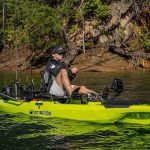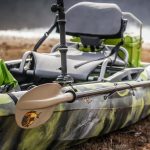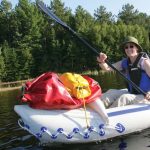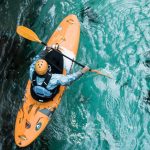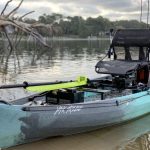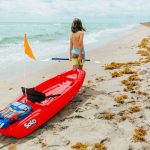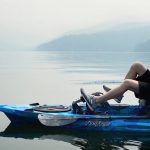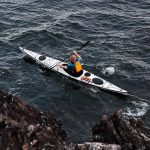Founded in 2016, Bonafide Kayaks is a relative newcomer to the kayak fishing market. 100% made in the USA, their kayaks are known for uncompromised quality and great stability. Let's see what Bonafide Kayaks has to offer in 2023.
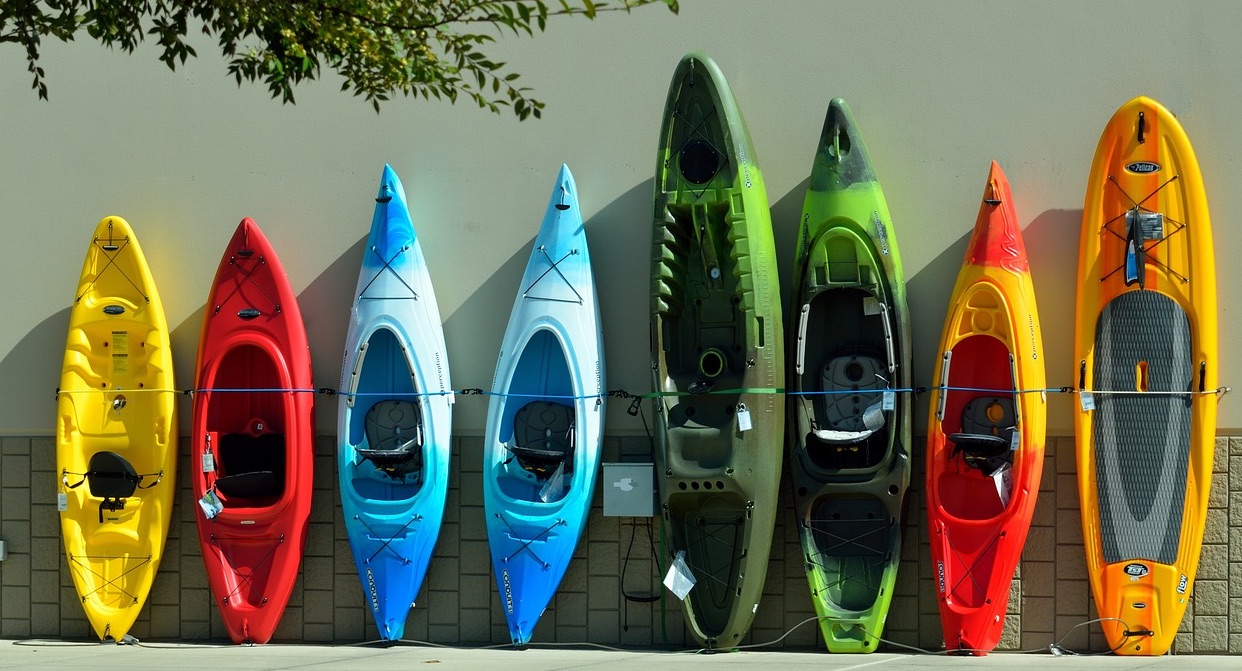
In a hurry? Our pick as the best beginner kayak is Wilderness Systems Pungo 120
This is our review of the best kayaks for beginners on the market today.
Kayaking is quickly becoming more popular worldwide, and for good reasons. It is one of the most inclusive sports that offers clear health benefits. It is also a lot of fun.
But if you’re just getting into it, buying your first kayak is a daunting task. There are so many great beginner kayaks on the market today, but which one is right for you? We understand how difficult it is to choose a kayak that best suits your needs, especially if you’re new to the sport.
We’ve put together this buying guide to help you choose your first kayak.
That’s why we’ve put together a list of the best kayaks for beginners. We chose our picks based on features, versatility, usability, and overall value. We’ve field tested many of those models over the years to bring you top beginner-friendly kayaks.
Note: don’t forget to also check our buying guides on PFDs and paddles.
As an affiliate of Amazon and other retailers, we may earn a small commission when you buy via our links, at no additional cost to you. Thank you!
Quick Answer: Best Kayaks for Beginners
- Wilderness Systems Pungo 120 – Best Overall
- Intex Challenger K1 – Best on a Budget
- Intex Explorer K2 – Best Buy
- Sevylor Quikpak K1 – Most Lightweight
- Perception Rambler 13.5 – Best Tandem for Beginners
- Sea Eagle 370 – Best Inflatable Tandem
- Lifetime Tamarack Pro 103 – Best for Fishing
- Perception Flash 9.5
- Pelican Maxim 100X
- Pelican Argo 100X
- Vibe Skipjack 90
- Sun Dolphin Aruba 10
- FeelFree Moken 10 V2
Comparison Table: Top Rated Kayaks for First-time Paddlers
| Model | Specs | Price |
Wilderness Systems Pungo 120 | LxW: 12’2″x 29″ Weight: 49 lb Capacity: 325 lb | See on Amazon |
Intex Challenger K1 | LxW: 9’x30″ Weight: 28 lb Capacity: 220 lb | See on Amazon |
Intex Explorer K2 | LxW: 10’3”x36” Weight: 36.7 lb Capacity: 400 lb | See on Amazon |
 Sevylor Quikpak K1 | Size: 8’7” x 3’ Weight: 18 lb Capacity: 400 lb | See on Amazon |
Perception Rambler 13.5 | LxW: 13’6″x 34″ Weight: 78 lb Capacity: 550 lb | See on Amazon |
Sea Eagle 370 | Size: 12’6” x 34″ Weight: 33 lb Capacity: 650 lb | See on Amazon |
Lifetime Tamarack Pro 103 | Size: 12’3″ x 31″ Weight: 57.5 lb Capacity: 300 lb | See on Amazon |
Perception Flash 9.5 | LxW: 9’6″x 28.5″ Weight: 40 lb Capacity: 300 lb | See on Amazon |
Pelican Maxim 100X | LxW: 10″x 28″ Weight: 36 lb Capacity: 275 lb | See on Amazon |
Pelican Argo 100X | LxW: 10″x 28″ Weight: 36 lb Capacity: 275 lb | See on Amazon |
Vibe Skipjack 90 | LxW: 9″x 32″ Weight: 46 lb Capacity: 300 lb | See on Amazon |
Sun Dolphin Aruba 10 | LxW: 9’6″x 28.5″ Weight: 40 lb Capacity: 300 lb | See on Amazon |
FeelFree Moken 10 V2 | LxW: 9’6″x 28.5″ Weight: 40 lb Capacity: 300 lb | See on Amazon |
Our Top Beginner-Friendly Kayaks for 2023
Wilderness Systems Pungo 120 – Best Overall

Weight: 49 lbs (22 kg)
Length: 12’2” (371 cm)
Capacity: 325 lbs (147 kg)
Type: Sit in
Of all the kayaks we tested over the years, the Wilderness Systems Pungo 120 is a long-time favorite pick for beginner and intermediate paddlers alike. It has been one of the best-selling recreational kayaks for nearly 25 years, and for good reasons.
Our favorite feature of the Pungo 120 is Wilderness Systems’ proprietary hull design which blends a wide base with a V-shaped hull. We like the kayak’s playful character and solid secondary stability, although it may seem a little unstable at the beginning.
The Pungo features a pretty hard chine and a pronounced keel, so it maneuvers very well and tracks marvelously over longer distances.
Another thing that impresses our testers is the very comfortable Phase 3 AirPro seating system. This adjustable and well-padded seat is one of the best on the market (another very comfortable seat is FeelFree Moken 10’s framed seat).
The Pungo 120 also has a set of thigh pads on the cockpit rim, which is another comfort feature you don’t often see on beginner kayaks.
Finally, the adjustable footrests ensure that every paddler will find the perfect position.
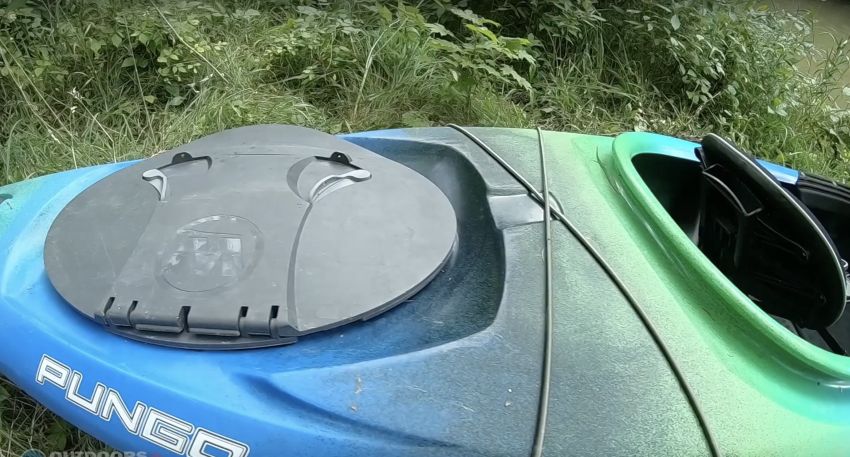
For gear storage, the Pungo 120 offers a huge rear bulkhead covered by a water-tight hatch.
This bulkhead is also an important safety feature. It creates a sealed compartment inside the hull and prevents the kayak from being flooded if you capsize.
There’s also some bungee rigging on the fore and aft decks for items you need access to while on the water.
Beginners will appreciate the built-in dashboard which provides plenty of storage space for snacks, water bottles, and other accessories. There’s even a storage spot for a lithium battery (sold separately) to keep your devices charged.
The 120 model has a weight limit of 325 lb (147 kg) which makes it appropriate for the majority of kayakers. If you’re a larger person, take a look at the Pungo 125 model which can carry up to 375 lbs. (170 kg). For small paddlers, there’s also the Pungo 105, which carries up to 300 lbs. (136 kg).
Intex Challenger K1- Best on a Budget

Length: 9 ft. / 274 cm
Width: 30 in. / 76 cm
Weight: 28 lbs. / 12.7 kg
Capacity: 220 lbs. / 100 kg
If you just want to try kayaking to see if you’re going to like it, the Intex Challenger K1 is a solid (and very affordable) pick for budget-minded beginners.
The kayak very light (28 lbs), which makes it the second lightest model on our list after Sevylor Quickpack. It comes with a paddle and a pump, so the only extra you need to buy is a solid PFD. The whole package fits into a compact bag, which is awesome for throwing in the trunk or RV for a weekend of camping.
Despite the compact size, our tests proved that the Challenger K1 is a fully functional kayak for small to medium adults and an even better option for teenagers or kids.

On the flip side, the Intex Challenger is made from vinyl, which isn’t as durable as reinforced PVC used in higher-end inflatable kayaks. If you plan to use this kayak on rivers, around rough banks, or near overhanging trees, you should take care not to end up deflated.
Once we reached the water, we had no problems assembling and inflating the kayak. The Boston valves fitted in the floor and the sidewalls allow you to get both chambers of this kayak up to pressure before you set off on the water. The seat inflates separately and attaches to the kayak with a velcro strip and a series of D-rings that keep it securely in place so it won’t move while you paddle.

The inflatable seat itself was adequately supportive and comfortable for an inflatable system. We had some issues with limited legroom inside the cockpit, however.
For a lightweight and low-budget inflatable kayak, the Challenger paddled surprisingly well. The skeg at the rear helps this kayak to track and, while we wouldn’t recommend getting caught out in strong winds, you will find it easy to go in a straight line on open water and gentle rivers.
As a short and wide kayak, Intex Challenger isn’t going to break any records, but it’s not designed to. It will be really easy for the whole family to paddle though, with low sidewalls and accessible design. Often that’s more important.
Intex Explorer K2 – Best Buy
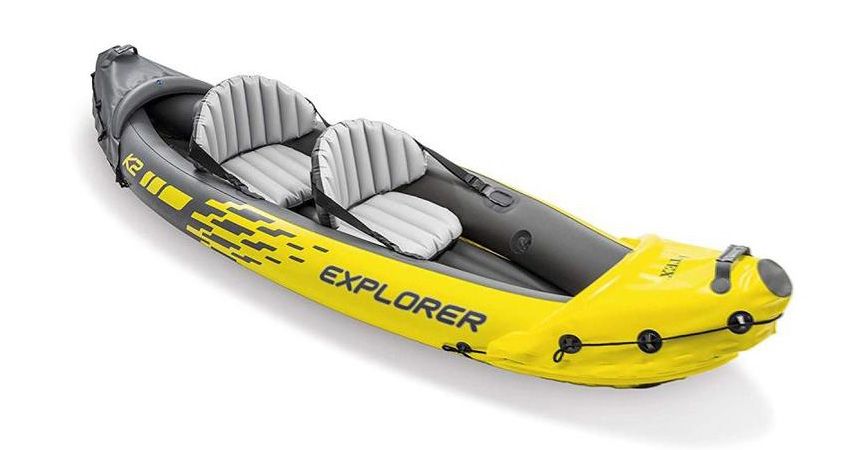
Length: 10’3” (312 cm)
Width: 36” (91 cm)
Weight: 30.6 lb (13.9 kg)
Capacity: 400 lb (180 kg)
This budget 2-person kayak is 10’3” (312 cm) long and 36” (91 cm) wide. It has an open, canoe-like design with small decks on the bow and the stern.
Tipping the scales at 30.6 lb (13.9 kg), the Explorer K2 is rated for up to 400 lb (180 kg). 400 lb is not that much for two people, so it’s best suited for smaller paddlers.
The boat is made from vinyl and includes 3 main inflatable chambers (2 sides and the floor). The two inflatable seats are attached with velcro strips on the bottom and side straps that provide back support.

Features include a removable skeg that helps with tracking as well as grab lines and carrying handles on the bow and the stern. The kayak comes with two aluminum-shaft paddles, a hand pump, a repair kit, and a carry bag.
Intex Explorer K2 is best used for short recreational paddles on small, calm bodies of water. Its compact size, lightweight construction, and low price make it an easy first step into kayaking. Whatever you do, do not go far from the shore in it, and always wear your PFDs.
For longer trips, look for models made from reinforced PVC, which is much more durable and puncture-resistant. Also bear in mind that this kayak is pretty short for a tandem, so it provides limited legroom, storage space, and capacity.
Sevylor Quikpak K1 – Most Lightweight
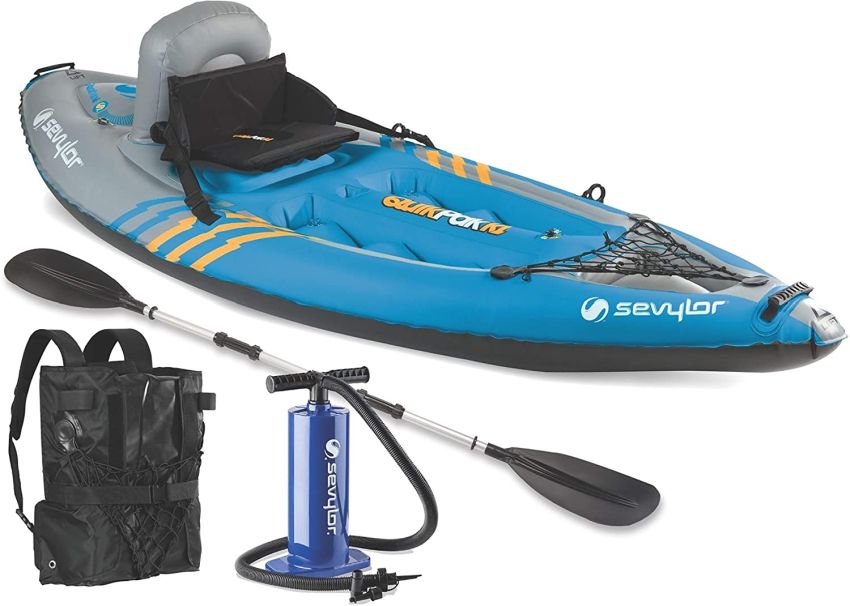
Length: 8’7” (262 cm)
Width: 3’ (91 cm)
Weight: 18 lb (8 kg)
Capacity: 400 lb (181 kg)
Sevylor Quikpak K1 promises a five-minute setup, a backpack that turns into the seat, a durable PVC construction with a puncture-protected floor, multiple air chambers for safety, and even integrated, inflatable footrests.
This small sit-on-top boat is 8’7” (262 cm) long and 3’ (91 cm) wide. Weighing only 18 lb (8 kg), it is light enough to carry for about any adult. The capacity of 400 lb (181 kg) is more than impressive for such a small vessel. The kayak features 5 inflatable chambers if you count the backrest and two inflatable footrests, so it will let you get to the shore even if you puncture one of the chambers. Still, the vinyl hull is not as durable as PVC used on higher-priced boats, so we would not recommend going far from the shore in it.
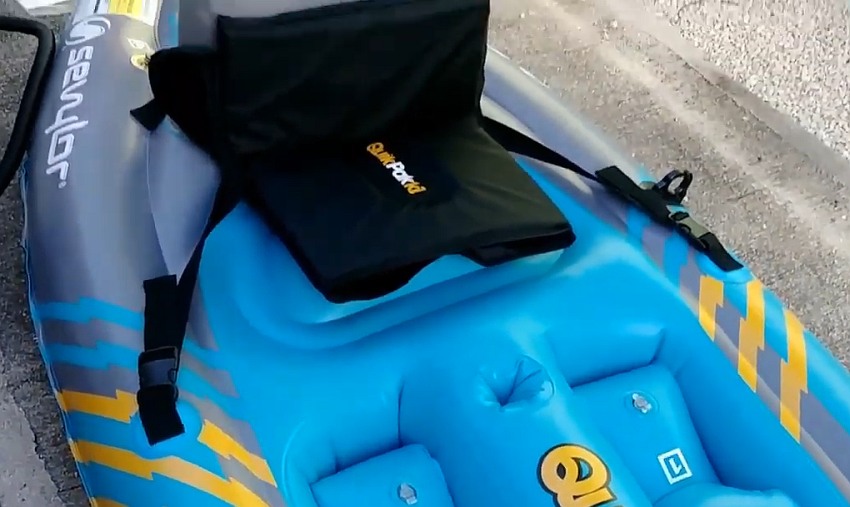
The kayak comes with a hand pump and a cheaply made collapsible paddle which you’d better replace immediately (see some quality budget options). Other features include a bungee net on the bow, a small flat storage platform behind the seat, a paddle holder, and two carrying handles.
The kayak’s sit-on-top design and generous capacity mean that even larger people will have enough legroom and feel safe while paddling.
Sevylor Quikpak K1 is a short and wide boat with a flat bottom (other than two tiny skegs that don’t do much), so you can’t expect to get any speed or tracking out of it. It also tends to be blown around by the wind quite a bit. In terms of stability, you should be OK on flat water, but this boat is not suitable for waves, wind, or current.
Overall, Sevylor Quikpak K1 can be recommended if you just want to try kayaking and see if you like it, or if you live in a small apartment with very limited storage space. It also makes a great beach toy. Its portability and low weight let you throw it in the trunk and leave it there just in case you need it.
Perception Rambler 13.5 – Best Tandem for Beginners

Weight: 78 lbs (35 kg)
Length: 13’6” (412 cm)
Capacity: 500 lbs (249 kg)
Type: Sit on top
A beginner-focused tandem for duos that like to take to the water together, the Perception Rambler 13.5 is one of the most affordable 2 person kayaks on the market.
Featuring a wide, mostly rounded hull that offers impeccable stability in calm conditions, the Rambler 13.5 is a solid choice for paddlers that enjoy sticking to sheltered waters. Its spacious deck area and high maximum weight capacity are able to accomodate 2 adult paddlers, plus a child or dog, making it a nice option for adventurous families.
Although the Rambler 13.5 is a bit heavier than many other similarly sized tandems on the market at 78 lbs (35 kg), since you’ll always paddle this boat with a partner, it’s still easy enough to load onto a vehicle.
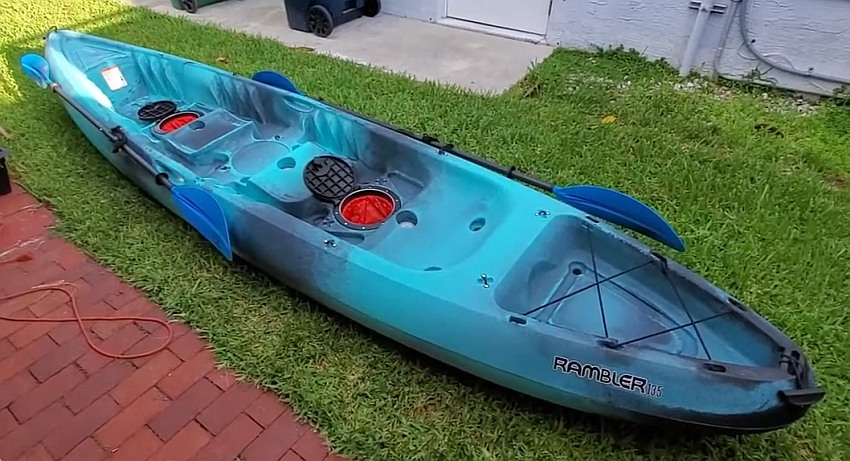
However, as Perception designed this boat to be affordable and beginner-friendly, it doesn’t come jam-packed with features. But, it does have a small rear tankwell that can hold a cooler with refreshments for a day on the water, as well as 2 padded seats for improved comfort while paddling.
Key Features
- Spacious deck area
- Stern tankwell for gear storage
- Adjustable, padded seats
Sea Eagle 370 – Best Inflatable Tandem
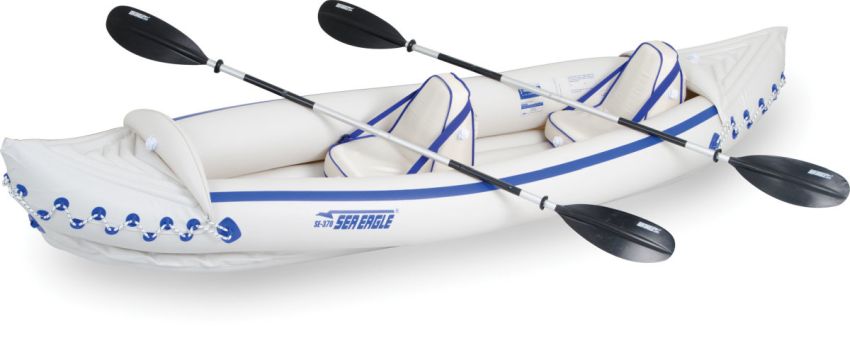
Length: 12’6” (381 cm)
Width: 34″ (86.4 cm)
Weight: 33 lbs. (15 kg)
Capacity: 650 lbs. (295 kg)
Sea Eagle 370 is marketed as a 3-person kayak, but in reality, it offers just enough space for 2 adults to sit comfortably.
Sea Eagle 370 is made from the K80 PVC (Polykrylar) material and features three separate inflatable chambers. Two plastic skegs on the bottom help the kayak track better.


The kayak comes in several configurations, including the Pro package with better inflatable seats and two paddles, the Solo Fishing package with one seat and a multi-purpose storage box, and even a QuikSail package with a small sail.
Sea Eagle 370’s larger interior and extra capacity make it possible to load the boat with gear. If you don’t need all that space, there is also a shorter (and slightly lighter) model, the Sea Eagle 330.
Lifetime Tamarack Pro 103 – Best for Fishing

Type: Hard-shell sit-on
Material: High-density, UV-protected polyethylene
Size: 12′ 3″ (312.42 cm) x 31″ (78.7 cm)
Weight: 57.5 lb (26 kg)
Capacity: 300 lb (136 kg)
The Lifetime Tamarack Angler is a great budget-friendly fishing kayak for those who want to try kayak fishing. This boat has just the right amount of fishing-specific features and comfort at a price that’s hard to beat.
The Tamarack Angler is relatively lightweight at just 51 lbs (23 kg), meaning it will be easy to load on a roof rack or into your truck. There isn’t an abundance of storage space, but this model does offer two dry storage hatches—one in front of the seat and one behind.
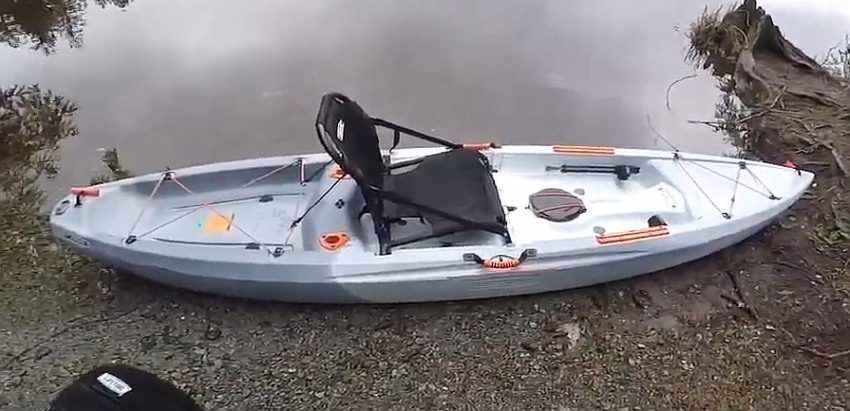
Crafted from UV-protected high-density polyethylene, the Tamarack Angler is designed to be a rigid, durable kayak that performs well on the water. Many users report that the kayak offers enough stability to allow them to stand while fishing. At just 10’ (304.8 cm) in length, the Tamarack Angler is a great throw-and-go boat that will shine on smaller lakes or calm rivers.
Pelican Argo 100X
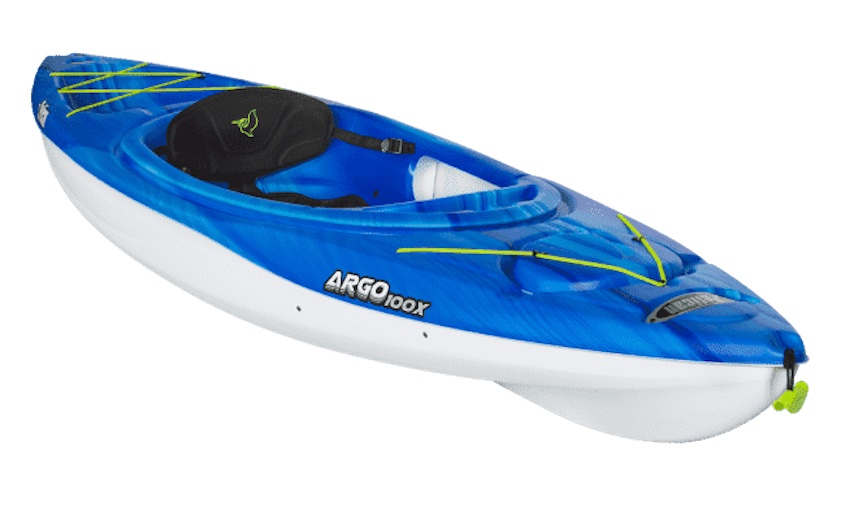
Length: 10’ (305 cm)
Width: 28″ (71 cm)
Weight: 36 lbs. (16.3 kg)
Capacity: 275 lbs. (125 kg)
Pelican Argo 100X is an insanely popular beginner-level kayak, mainly due to its wide availability and great pricing. At 36 lbs (16.3 kg), it is also a very lightweight boat that you can literally grab one-handed and carry around.
At 10’ (305 cm), it is a little shorter than the AdvancedFrame above but still offers enough room for an average-sized adult. The Argo’s maximum capacity is 275 lbs (125 kg) – not much if you include your clothes, PFD, paddle, and all of your gear. For better performance, it’s a good idea to stay within 80 percent of the kayak’s capacity, which brings the available capacity down to 220 lbs or 100 kg.

Like most Pelican models, Pelican Argo 100X is made of RAM-X material using thermoforming technology. RAM-X is a three-layer sheet of high-density polyethylene. A sheet of RAM-X is heated up and stretched over a mold using a vacuum. Two parts of the hull are then melted together, creating a strong bond.
Thermoformed kayaks are lighter than rotomolded ones but are considered less durable.
Vibe Skipjack 90

Length: 9’ (274 cm)
Width: 32” (81 cm)
Weight: 46 lb (21 kg)
Capacity: 300 lb (136 kg)
Whether it’s exploration or fishing you’re after, the Skipjack 90 might just be the perfect way to introduce new kayakers to the sport. The short, stable platform is versatile and highly portable, lightweight enough that you can just grab and go with the molded side handles.
For recreational exploring, the Skipjack’s defined waterline and easy maneuverability makes taking to the water as easy as possible, while the waterproof, breathable seat pad and supportive back rest system mean you can stay out paddling all day.

You will appreciate the large amounts of storage at either end of the kayak, as well as the central tackle toss recess and base accessory mounting point. There are also four recessed rod holders on the Skipjack, which can double as GoPro mounts if filming is important to you.
The paddle park, drinks holder and a waterproof hatch, ideal for small items such as cameras and phones, can be invaluable for any paddler.
Key Features
- Molded carry handles
- Bow and stern tank wells with bungees
- Quarter-turn day hatch
- Flush-mounted rod holders
Sun Dolphin Aruba 10

Length: 9′ 7″ / 292 cm
Width: 29″ / 74 cm
Weight: 40 lbs. / 18 kg
Capacity: 250 lbs. / 113 kg
No-frills, yet functional as can be, the Sun Dolphin Aruba 10 is an über-popular kayak for beginners and intermediate paddlers, alike.
Made with a thick layer of UV-stabilized Fortiflex high-density polyethylene, the Aruba 10 is meant to last throughout years of use by the whole family. It has a spacious cockpit for easier entry, plus a well-padded, fully-adjustable seat and thigh pads for improved comfort on the water.
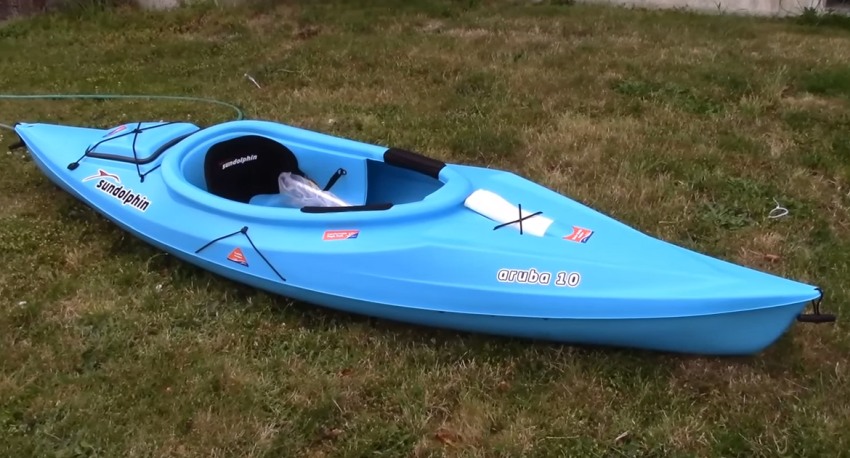
With this boat you get a set of adjustable foot braces, which are hard to come by at this price point. As a result, you can start to get a feel for maneuvering your kayak through tricky terrain, which will help you improve your technique over time.
Moreover, the Aruba 10 has a rear storage compartment and a cockpit water bottle holder for convenience on longer paddles. Finally, although the boat isn’t the lightest on the market, its 2 handles make it fairly simple to lift and transport at the end of your paddling day with the help of a friend.
Key Features
- Fully adjustable seat
- Large rear storage hatch
- Adjustable foot braces
FeelFree Moken 10 V2

Weight: 68 kg (30.8 kg)
Length: 10’ (305 cm)
Capacity: 440 lbs (199.6 kg)
Type: Sit on top
When casting lines and snagging your next catch while paddling along calm waters is your ideal way to spend a weekend, the FeelFree Moken 10 V2 might just be what you need. This angler-friendly sit on top kayak packs a whole lot of comfort and functionality into one compact boat.
We were impressed by this kayak’s wide hull that offered adequate stability in the water. A reinforced, non-slip standing platform was comfortable for standing up and casting.
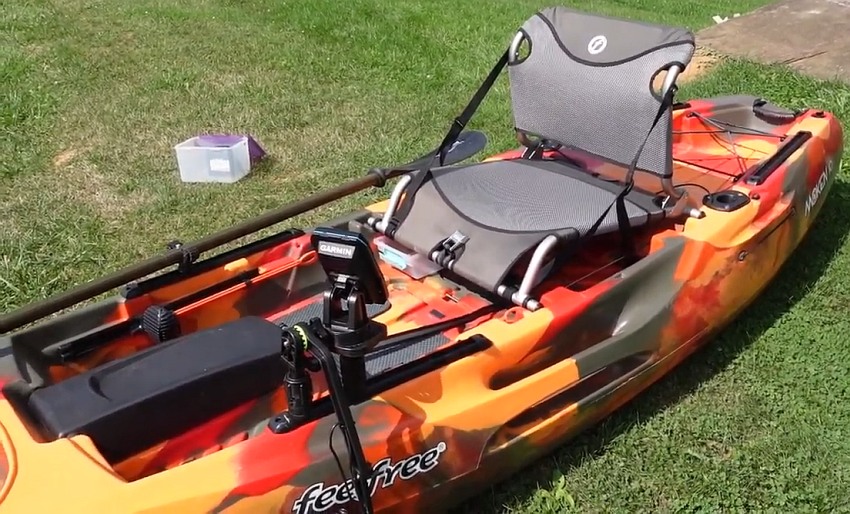
A major selling point of the Moken 10 is how comfortable it is. The EZ Rider seat is height-adjustable and has an ergonomic backrest for longer days on the water. We also appreciated the adjustable footrests that helped us find an optimal paddling position.
The Moken 10 V2 comes with 2 flush-mounted rod holders and multiple Uni-Track gear tracks which let you attach various fishing-specific accessories to enhance your time on the water.
A small downside of the FeelFree Moken 10 V2 is that, unlike its bigger brother Moken 12.5, the 10-foot model does not include a fishfinder pod. There is a simple storage pod instead.
RELATED: FeelFree Kayaks in 2023: Full Model Lineup and Reviews
Oh, and Since it also comes with bow and stern tankwells, plus multiple storage areas for your gear, this boat is ideal for anglers that expect to reel in an impressive catch at the end of the day.
Key Features
- EZ Rider height-adjustable seat
- 2 flush mounted rod holders
- Multiple Uni-Tracks for accessories
How to Choose Your First Kayak: Factors to Consider
Buying a kayak for beginners isn’t always as easy as it might seem. That’s because you want to be sure that you get a boat that’s stable and comfortable enough for your first few years of adventures on the water.
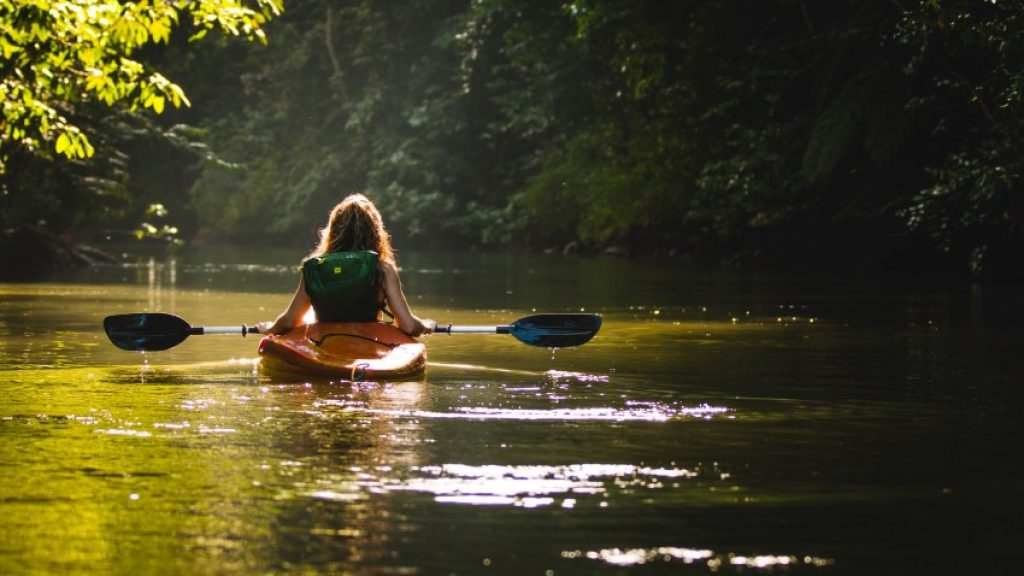
To help ensure that you get the best beginner kayak for your needs, here are some of the most important features and design points that you should consider when shopping around.
Tandem vs. Solo
Perhaps the first major decision you need to make when buying your new kayak is whether you’d like a solo or a tandem model. In reality, this is very much so a personal decision as it depends on whether or not you can reasonably expect to have a willing and excited padding buddy available for your adventures.
With that in mind, it’s worth noting that there are some advantages and disadvantages of choosing a single or a tandem kayak as a newer paddler.
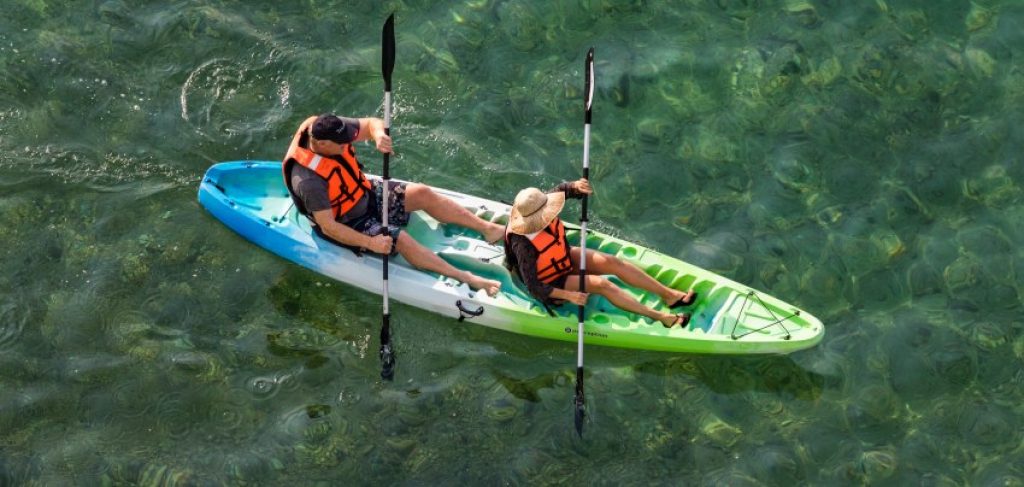
For example, tandem kayaks tend to be more stable and better at tracking, partially because they are usually longer and wider than their solo counterparts. However, this extra width and length comes at the expense of portability.
Moreover, tandem boats can be both frustrating and fun to paddle if you’re just starting your kayaking career. While having a buddy in the boat with you can be calming if you’re feeling a little nervous, it can also be frustrating to feel like you’re only going in circles because your paddling timing is out of sync.
At the same time, a solo kayak is often better from a skills progression point of view because you’ll need to develop proper technique on your own without relying on anyone else to make corrections for you.
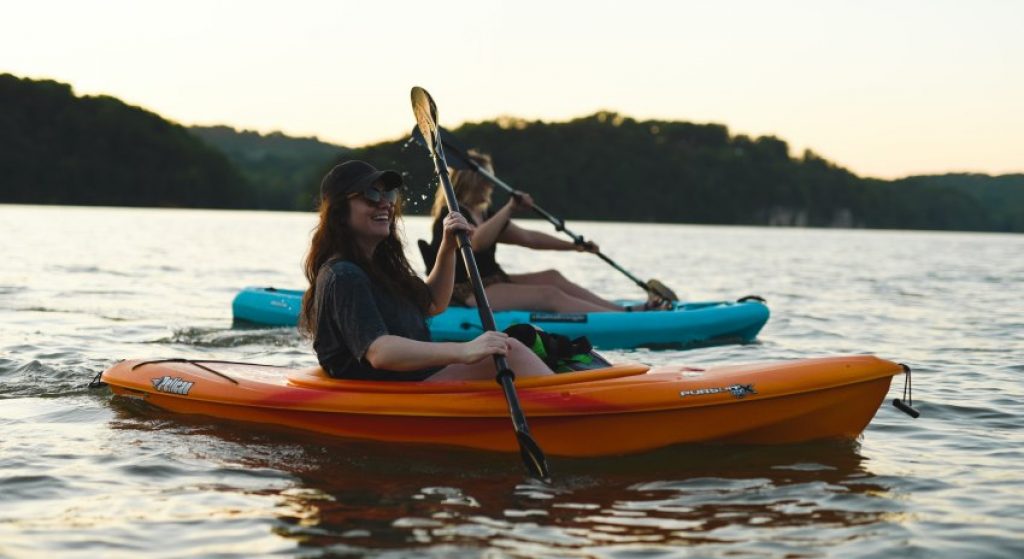
What does this mean for you?
Well, if your main goal for kayaking is to just enjoy yourself on the water with your friends and family, or you’re only interested in purchasing 1 boat for 2 people, a tandem might be the best option. Alternatively, if you’d like to really hone your paddling technique, a solo kayak is going to give you the best opportunity to do so on the water.
Sit on Top vs. Sit In
After you decide whether you’d like a tandem or solo kayak, your next big decision is whether you’d prefer a sit on top or a sit in kayak. Here’s what you need to know about the advantages and disadvantages of each type of boat.
Sit on Top Kayaks
Sit on top kayaks are perhaps the more popular option for beginner kayak because they offer easy entry and exit and plenty of space to sit back and relax. The open deck of a sit on top kayak is also ideal for larger paddlers or anyone that often feels claustrophobic inside a sit in kayak.
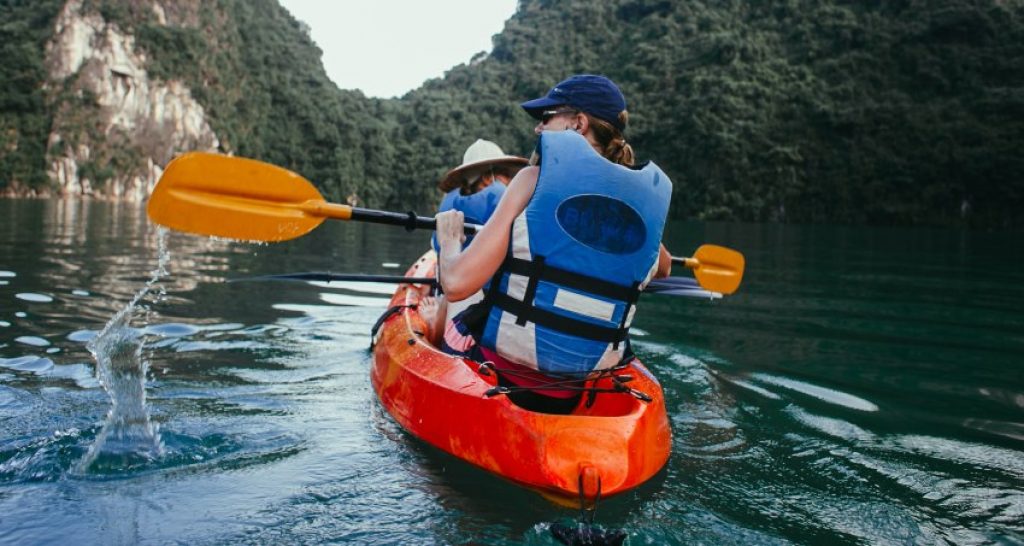
Moreover, from a beginner paddler’s perspective, sit on top kayaks are quite user friendly. If you do happen to capsize, you don’t have to worry about trying to slide out of a cockpit while you’re underwater. Plus, most sit on top boats are self-bailing, which is nice if you do end up going for a swim.
That being said, sit on top boats aren’t a great choice if you don’t like to get wet while paddling. They’re also less ideal in choppy conditions, though, to be fair, most beginner kayaks aren’t designed for harsh weather, anyway.
Sit In Kayaks
Sit in kayaks are the more traditional choice as they have a cockpit area that encloses most of your lower body. While expedition and touring-style sit in kayaks tend to have very narrow cockpits, however, most beginner-friendly models have fairly wide cockpit openings.
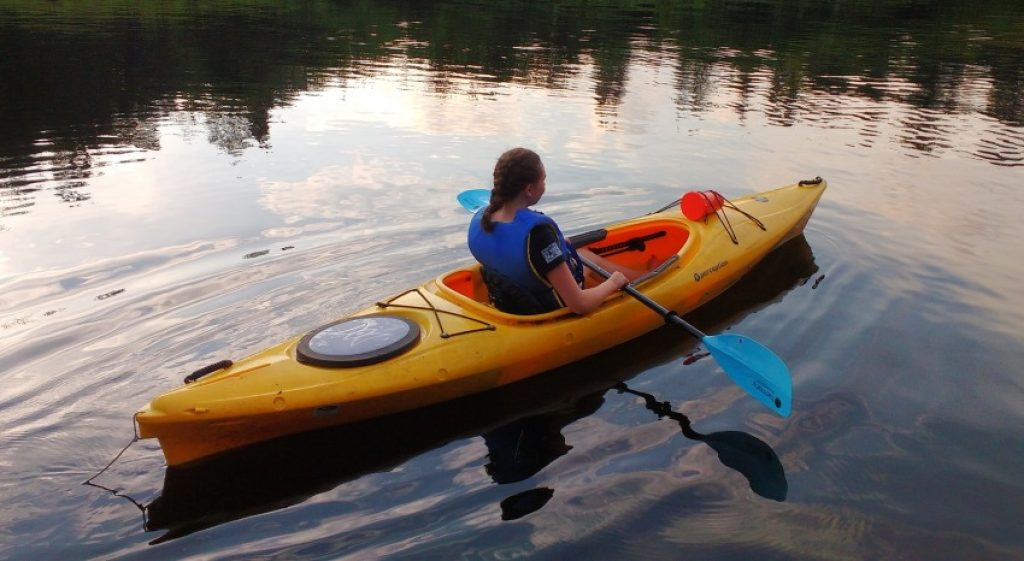
The primary advantage to a sit in kayak is that you’re better able to brace your knees on the side of the kayak for improved maneuverability and more efficient paddling in choppier waters. You also tend to get less wet in a sit in kayak because your lower body is mostly protected by the cockpit.
Of course, this added protection comes at the expense of ease of entry and comfort. Unless you purposefully buy a sit in kayak with a wide cockpit opening (which is common on most beginner models), it can be trickier to get in and out of the boat.
Hull Shape & Design
The vast majority of beginner-friendly kayaks come with a mostly rounded hull. This is not a coincidence as wide, rounded hulls tend to be best from a stability point of view.
For new kayakers, feeling comfortable and confident in your boat is a top priority. Therefore, most manufacturers opt for rounded hull designs which offer the most in terms of stability.
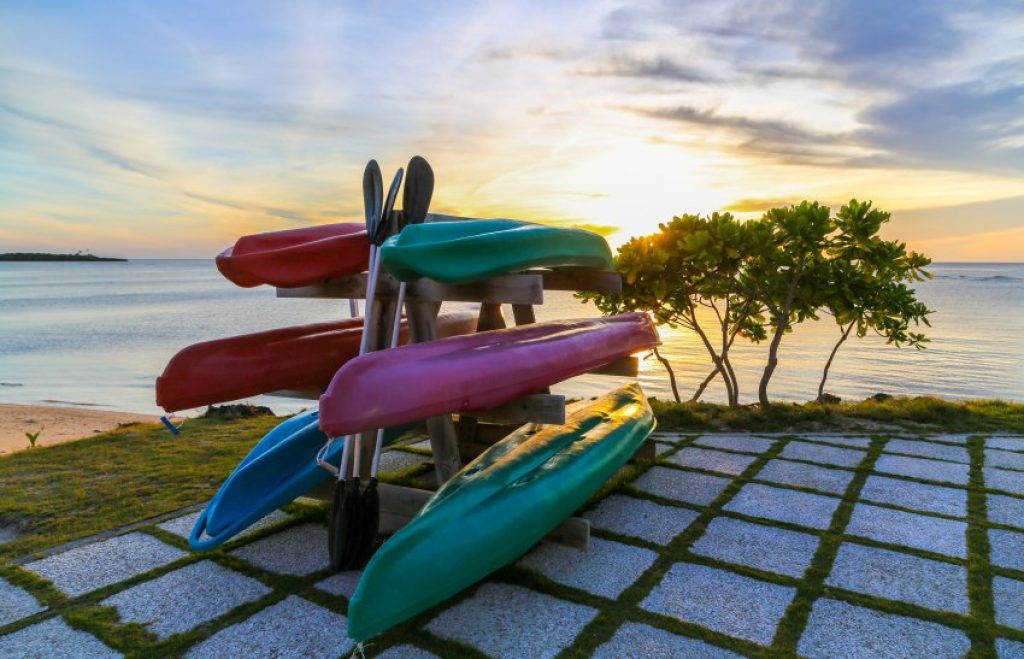
Keep in mind, however, that this rounded hull design, while nice from a stability and maneuverability point of view in calm water, is less ideal for tracking over long distances.
Moreover, boats with rounded hulls, while stable in mostly flat water (called primary stability), have minimal secondary stability. This means that they’re quite tippy in choppy water as the boat rolls up onto its side.
Does this mean you shouldn’t buy a boat with a rounded hull?
Not at all. Rather, it means that it’s important to understand the limitations of your boat’s hull construction. Therefore, most beginner kayaks are best used in sheltered areas in mostly calm conditions.
Kayak Size & Weight
A kayak’s size and weight is mostly a concern when it comes to portability, though the length of your boat can also have an impact on it’s natural tracking ability.
For example, shorter, lighter boats are highly portable, which is ideal if you have to frequently carry your kayak to and from a put-in. However, this portability comes at the expense of your boat’s tracking ability, which means that it’s often harder to paddle in a straight line.
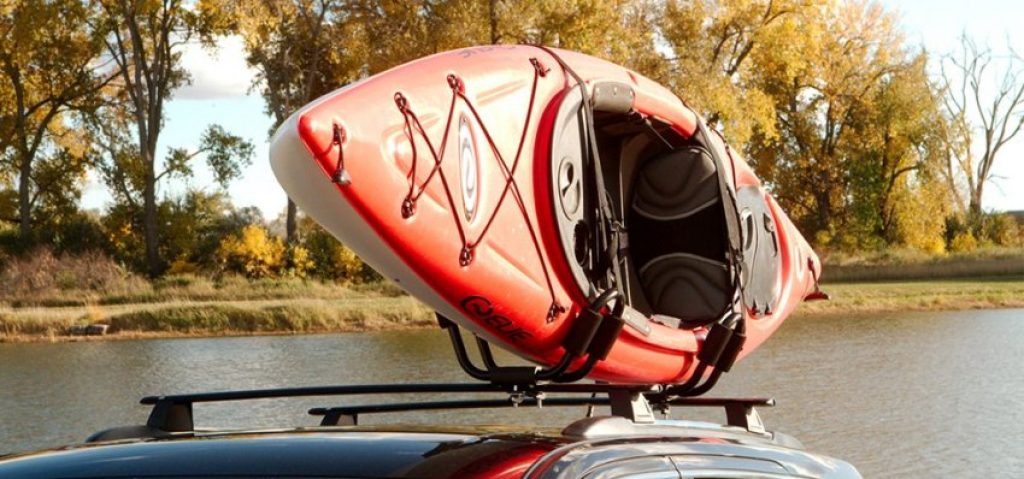
Smaller boats also have smaller gear storage capacity, which may be a concern if you’re looking to spend long periods of time on the water.
A longer boat can offer more in terms of gear storage and natural tracking ability. However, these kayaks are heavier and may be harder to cartop. You may even need a kayak trailer and a kayak cart to handle it.
Therefore, the size and weight of your kayak is a trade-off between portability, gear storage, and tracking ability.
Maximum Weight Capacity
Every kayak comes with a stated maximum weight capacity, which is an important factor to keep in mind as you shop. For maximum performance in your new boat, it’s best not to load it beyond 80% of the manufacturer’s listed weight capacity.
When deciding which kayak is best for you, be sure to account for your weight and the weight of your gear when determining if a given model is suitable for your paddling needs. Additionally, if you’re looking to buy a tandem boat, you’ll need to factor in the weight of your paddling partner to ensure you get a model that’s appropriate for both of you.
Comfort
Comfort is key for new kayakers as you want to feel calm and collected when on the water. Indeed, no one wants to go kayaking if they know that they’ll be uncomfortable the whole time, so getting a boat that feels nice to paddle is ideal.
With kayaks, comfort is a function of both legroom and seat padding. Sit on top kayaks tend to be best for maximizing legroom, due to their open decks, though there are plenty of beginner-focused sit in kayaks that have spacious cockpits for you to enjoy.
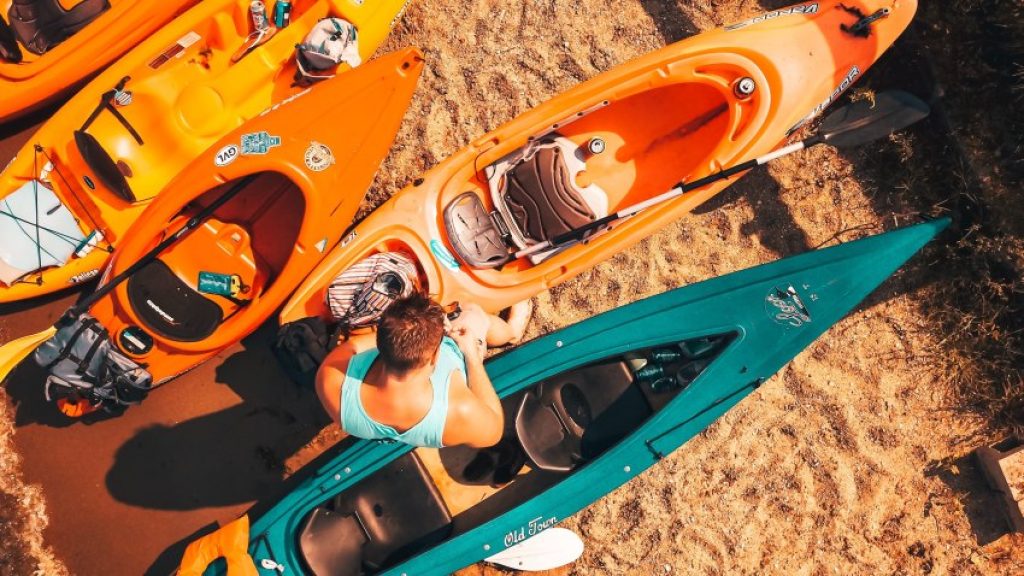
You’ll also want to consider a boat that has a well-padded foam seat for longer days on the water. An adjustable seat is also advantageous if you want to fine-tune your boat to best meet your needs while paddling.
Gear Storage Options
Depending on what you plan to use your kayak for, you may find that gear storage is an important feature in your new boat. For folks that like to fish or go on longer paddles, having a bit of gear storage space is a must in a kayak.
Most kayak gear storage comes in the form of an open tankwell or a closed hatch. Tank wells are best for people looking to pack bulky gear, like coolers, while hatches are best for protecting or storing smaller bits of gear. Keep in mind, though, that you’ll often pay extra for gear storage space on your kayak, especially if you want covered dry hatches.

